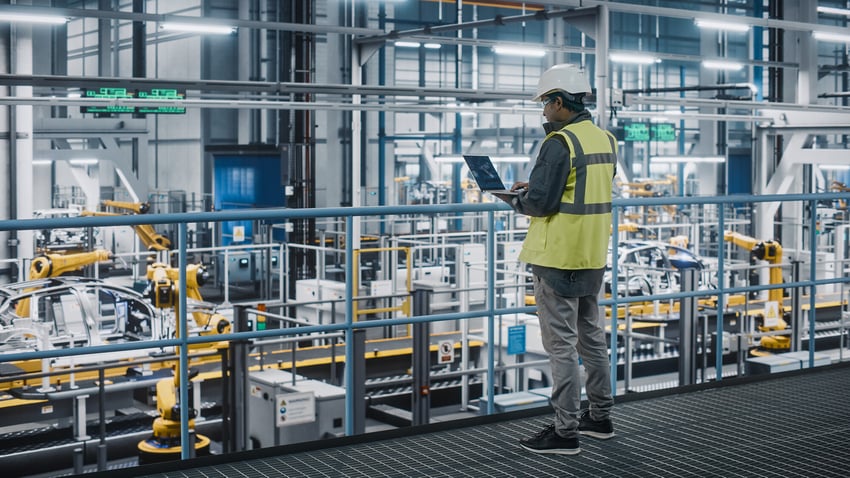Is your material handling process secretly costing you downtime?

For industrial manufacturers, unplanned downtime is one of the most costly and disruptive challenges. Every minute of lost production can translate to significant financial losses, supply chain bottlenecks, and operational inefficiencies. But while businesses typically focus on machine reliability and maintenance schedules, how often do they question the role material handling plays in unplanned disruption?
The cost of downtime in manufacturing
According to industry reports, downtime can cost manufacturers up to $125,000 per hour, and for automotive manufacturers, the impact is even greater - with estimates reaching $22,000 for every minute of production stoppage.
A Forbes Technology Council study further highlights the scale of the issue, revealing that unplanned downtime costs industrial manufacturers as much as $50 million annually. For manufacturers in the Fortune 500, downtime accounts for an average loss of 11% of total revenue, making it a critical factor in overall business performance.
Downtime is more than just lost output
The impact extends far beyond lost production – higher labour costs, missed customer commitments, and reputational damage compound the issue.
While direct production losses are the most obvious consequence of downtime, the true cost is far greater. Beyond lost output, companies incur:
- Increased labour expenses – paying workers for idle time or to cover extra shifts to make up for lost production.
- Expedited shipping costs – rushing materials or finished goods to meet delivery deadlines.
- Inventory imbalances – disruptions can lead to either excess stock or shortages.
- Impacts on customer perceptions – missing delivery expectations damages brand reputation.
The role of material handling in downtime
One major yet often overlooked contributor to downtime is inefficient material handling.
If a factory worker from the 1950s stepped onto a modern production floor, they’d be awestruck by the automation, robotics, and data-driven systems designed to track everything from OEE to TAKT time. But after the initial amazement wore off, they’d notice something familiar, someone manually pushing a kitting cart, just as they did decades ago.
The same goes for a veteran gas-powered forklift operator, who might raise an eyebrow at the sleek, lithium-powered lift trucks, but once they watched the daily routine of drivers shuttling single pallets of parts back and forth, one at a time, from storage to the line - they’d quickly recognise that, in many ways, material handling remains unchanged.
The reality is that material handling lurks beneath the surface in manufacturing, often overlooked, yet quietly draining efficiency and adding unnecessary costs. Every unnecessary movement of materials represents wasted time, labour, and energy. While manufacturers invest millions in advanced production technologies, many still underestimate the impact of outdated or inefficient handling processes on overall downtime.
The reality is that when material handling systems are not fit for purpose, facilities experience unnecessary downtime. Typical causes include:
- Frequent stoppages caused by inefficient routing or poorly planned workflows.
- Breakdowns and equipment failures due to improper load handling or inadequate maintenance.
- Wasted labour hours spent on excessive material movement rather than value-adding tasks.
- Unsuitable material handling equipment.
- A reactive maintenance approach (run-to-fail strategy) is a high-cost, high-risk method that leads to excessive downtime when equipment fails.
Maximising uptime with effective material handling equipment
Investing in reliable and flexible equipment is key to mitigating the challenges of downtime and material handling processes.
When it comes to the effectiveness of handling equipment, there are several potential areas to explore:
Equipment suitability
- Right tool for the task – Is the equipment suited to the loads and distances it needs to cover? Mismatched equipment leads to inefficiency, damage, and higher failure rates.
- Operational relevance – Does the equipment work with the current demands of the facility? If operations have changed but handling solutions haven’t, the likelihood of bottlenecks and downtime increases.
- Utilisation efficiency – Is equipment being used effectively? Equipment that is sat in the corner of the factory gathering dust isn’t helping anyone. Regular assessments ensure equipment is being utilised and optimised for performance.
Predictive maintenance
Moving from reactive to predictive maintenance allows manufacturers to anticipate failures before they occur, reducing unexpected stoppages.
- Real-time equipment health tracking – Detects early signs of failure, preventing sudden breakdowns.
- Reduced maintenance costs – Avoids unnecessary maintenance and only services equipment when needed.
- Higher asset utilisation – Maximises the working life of handling equipment.
Automation
Not all material handling tasks require manual or human intervention. Many non-value-adding, highly repetitive movements are ideal candidates for automation, allowing businesses to maximise efficiency whilst freeing up operators for higher value work.
The best approach is to assess where automated solutions can have the biggest impact, with the least amount of effort, and starting there initially.
- Process efficiency – Automated systems reduce the need for repetitive and strenuous manual handling, lowering cycle times and improving consistency.
- Workforce optimisation – Operators can be redeployed to more critical tasks rather than spending time on repetitive transport jobs.
- Reduced downtime risk – Automated solutions minimise human error and unnecessary delays, ensuring continuous material flow.
The takeaway? Take a detailed look at your material handling
Maximising uptime isn’t just an operational goal, it’s a strategic necessity in order to remain competitive. Yet, many manufacturers continue to overlook the significant impact that optimising material handling processes can have in reducing downtime and improving overall efficiency. Every unnecessary movement, every outdated process, and every inefficiency adds up, chipping away at productivity and profitability.
Taking a critical look at material handling processes and equipment suitability can uncover hidden inefficiencies that, when addressed, have the potential to drastically reduce downtime, streamline operations, and improve overall efficiency. In a world where every second of lost production carries a heavy cost, optimising material handling isn’t just an opportunity, it’s a competitive advantage.
